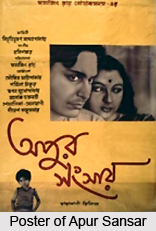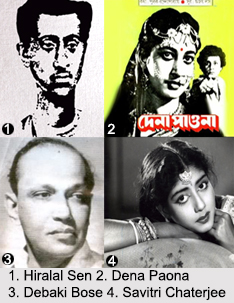 The casting ensemble for Apur Sansar (1959) included debutants Soumitra Chatterjee as Apu and Sharmila Tagore as Aparna. Swapan Mukherjee played the part of Pulu while Alok Chakravarty is Kajal. Besides them Sefalika Devi, Dhiresh Majumdar and Dhiren Ghosh were seen in the roles of Pulu`s wife, Sasinarayan and the landlord respectively.
The casting ensemble for Apur Sansar (1959) included debutants Soumitra Chatterjee as Apu and Sharmila Tagore as Aparna. Swapan Mukherjee played the part of Pulu while Alok Chakravarty is Kajal. Besides them Sefalika Devi, Dhiresh Majumdar and Dhiren Ghosh were seen in the roles of Pulu`s wife, Sasinarayan and the landlord respectively.
Apur Sansar presents Apu as an unemployed youth. He resides in a rented room beside a railway yard. He is looking for a job and sells his books to pay the rent. While searching jobs Apu faces several undesired situations as well. He is tormented yet he is working on a novel that is based on his own life and he dreams of making it big in the world of writing. However his life is changed forever as he accompanies his friend Pulu to the marriage ceremony of his cousin. On the way to the village Pulu reads his manuscript and appreciates it.
It unfortunately turns out on the day of the wedding that the bridegroom is mentally handicapped. The marriage is cancelled. However the villagers opine that if the girl does not get married in that pious hour she will be doomed. On Pulu`s coercing Apu relents to marry his cousin, Aparna, without even taking a look at her.
 The roles of the protagonists are played by two newcomers: Soumitra Chatterjee and Sharmila Tagore. Soumitra had a tryst with acting on stage for a short time and Sharmila Tagore was completely new. Satyajit Ray would literally shout instructions to her. But when one watches the movie, Apur Sansar, they are as good as seasoned actors. For her part Sharmila looks immensely beautiful as Apu`s young wife.
The roles of the protagonists are played by two newcomers: Soumitra Chatterjee and Sharmila Tagore. Soumitra had a tryst with acting on stage for a short time and Sharmila Tagore was completely new. Satyajit Ray would literally shout instructions to her. But when one watches the movie, Apur Sansar, they are as good as seasoned actors. For her part Sharmila looks immensely beautiful as Apu`s young wife.
Returning to the plot, the marriage takes place and Apu returns to Kolkata with his wife. With time love blossoms between the two and Apu takes up a clerical job to support the family. He had been avoiding the same job for months. The bond that develops between Apu and Aparna is beautiful. Their scenes in Apur Sansar leave an indelible mark on the minds of the audiences. Through trifle situations Ray portrays the affection between the two. The first change in Apu`s life is shown through his room. Being a bachelor`s room it was disorganised and there were no curtains on the window. The presence of a woman changes the look of the room. There are pillows on the bed, curtains on the windows and a plant on the shelf for decoration.
Their intimacy too is developed in a style that only Ray could manage. Apu wakes up in the morning to find Aparna busy with household chores. He finds a hairpin lying between the pillows. He keeps on gazing at his wife and then picks up his packet of cigarettes. When he opens it he finds a small note written by Aparna reminding him that he has promised not to smoke more than one and that too after meals. Smilingly he puts the pack away. Even without showing any embrace Satyajit Ray successfully establishes the intimacy that has developed between the husband and wife. However this marital bliss is short lived as Aparna dies at childbirth and Apu is left to deal with yet another death.
Another scene that leaves a lasting impression is the scene where Aparna lights a match for Apu`s cigarette. The flame makes her face glow and Apu inquires playfully that what is in her eyes. Aparna answers, "Kajal." Incidentally their son is named Kajal. Aparna writes to Apu and he is carrying the letter with him. As Apu opens the letter in office itself the content is conveyed in Aparna`s voice. As Apu is reading the letter he is interrupted by a fellow clerk. Midway through the letter he keeps it back in his pocket and continues reading it in a crowded home while returning home. This time a fellow passenger peeps in and he puts it away again. He peacefully finishes reading it as he walks home by the railway lines. Apu`s yearning to read Aparna`s letter and the hurdles he has to come over to complete it are simply brilliant.
Apu reaches home in a happy mood only to find his brother-in-law waiting with bad news. He suspects it. The message of Aparna`s death is conveyed to him. Being a Satyajit Ray film there is no melodrama. Apu`s immense grief is apparent when he slaps the messenger and then collapses on the bed. Till date this scene is considered a lyrical interpretation of emotions in Apur Sansar. He feels his `sansar` (world) has shattered. He does not leave his bed for days and even contemplates suicide. This contemplation is beautifully evoked by the sound of the passing train. Its sound stirs up new emotions on his blank face. The screen turns white and smoke rises from below. The camera moves back to focus on Apu and he is seen by the railway tracks. As he for his own suicide his spell is broken by the noise of a pig which had been ran over by the train.
Heartbroken he refuses to see his own child holding him responsible for Aparna`s death and their separation. Apu leaves Kolkata and leads the life of the wanderer. After 5 long years Apu is contacted by Pulu, his friend. Pulu is shocked the way in which Kajal is being brought up. The child has become wild and does not listen to anybody. He asks Apu to take his only son`s responsibility.
Unwillingly Apu comes back to the village and meets his son for the first time. Surprisingly he is overjoyed to see Kajal, his son. Tables are turned as now Kajal refuses to accept Apu as his father. He tries to pursue his son but fails. Defeated Apu decides to leave. In one of the last scenes in Apur Sansar Kajal`s grandfather tries to strike the child as he refuses to leave with his father and Apu rescues the child. As Apu leaves, the child joins him, accepting him as a friend rather than a father, and the father son duo leaves to begin afresh together.
Apur Sansar was a commercial hit. Soumitra Chatterjee and Sharmila Tagore became stars overnight. It is the last part of the Apu Trilogy that also included Pather Panchali and Aparajito. Soumitra Chatterjee went ahead to team up with the ace director 15 times and delivered some of the classic Bengali films. Sharmila Tagore went to Mumbai and became a successful actress in Bollywood but she did return in Ray`s films from time to time.
Apur Sansar received several awards:
• President`s Gold Medal, New Delhi (1959)
• Sutherland Award for Best Original and Imaginative Film, London (1960)
• Diploma of Merit, 14th International Film festival, Edinburgh (1960)
• Best Foreign Film, National Board of Review of Motion Pictures, USA (1960)
Apur Sansar brings to end the journey of Apu from childhood, adolescence to maturity. The three films represent the journey of life that every individual goes through. The magic of Apur Sansar lies in which the simple intimacies between two individuals or the relationships are evoked and portrayed the rough images. Apur Sansar is truly a wok of art and art never fades. It was and it will remain a masterpiece for all the ages to come.




















